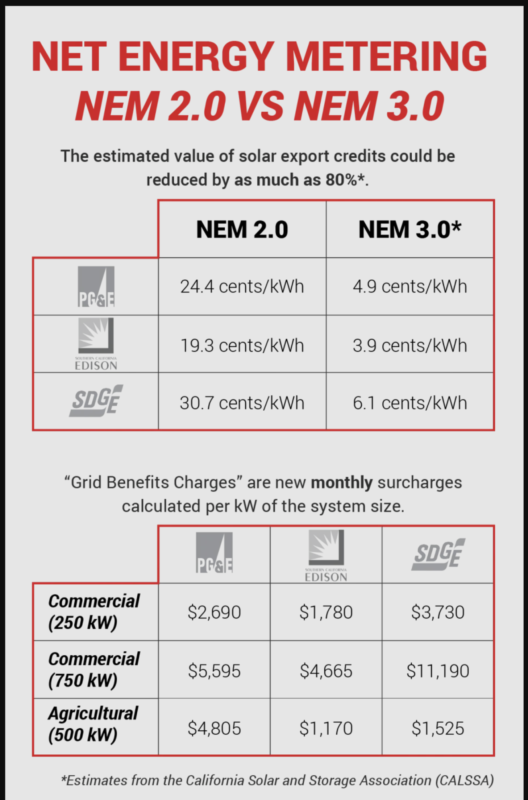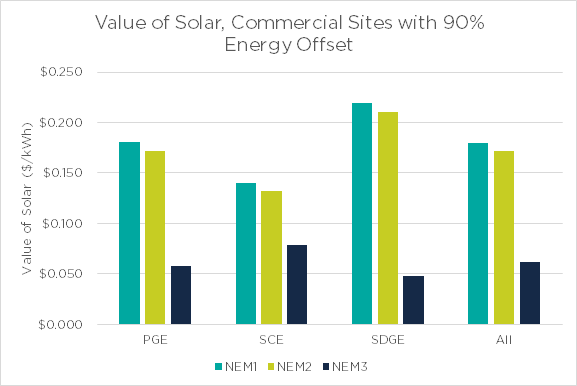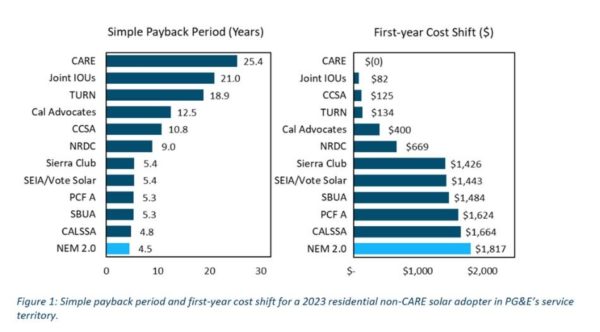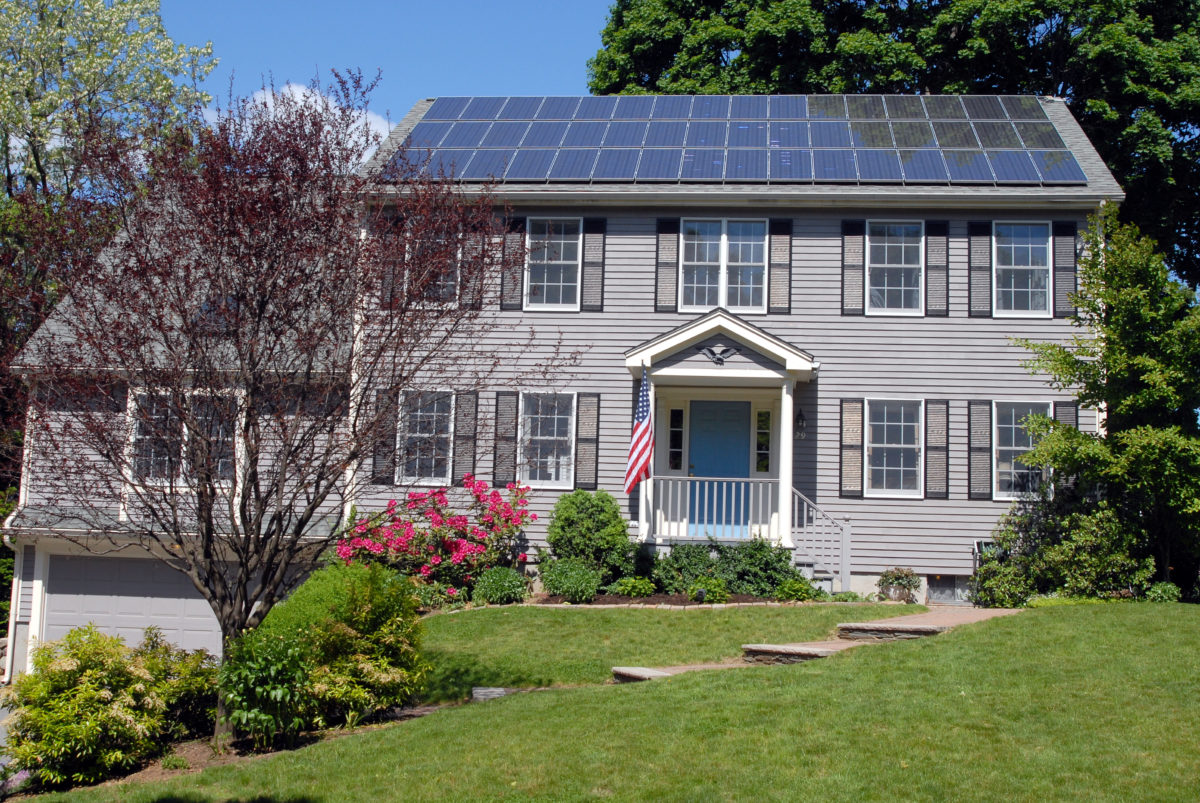Sometime soon – maybe as soon as today – the nation’s largest rooftop solar power market, residing in the state with the most grid-connected solar, will vote on how to financially compensate over 10 gigawatts of installed, net-metered capacity on homes and businesses. California’s vote will be its third iteration of net metering – NEM-3.
The vote is highly charged. At least 17 parties have submitted opinions backed by financial and legal arguments sent directly to California’s Public Utility Commission (CPUC). The whole of the legal filings – thousands of pages of documents – can be found on the CPUC website.
Various parties are arguing in favor of an 80% reduction to solar’s net-metering value, as well as monthly fees of $75 for homeowners with solar systems attached to the grid. Commercial customers could be facing fees from $800 to $3,400 per month. These fees would negate most of the savings for installing solar power.
Included among the list of groups in favor of strong net metering compensation are the California Solar & Energy Storage Association (CALSSA), the Clean Coalition, the Solar Energy Industries Association (SEIA) and Vote Solar, the California Energy Storage Association, and others. Those submitting proposals that are less supportive of rooftop solar include the Sierra Club, the Natural Resources Defense Council, multiple wind power associations, as well as the power companies.
CALSSA submitted a 255 page document, which outlines their own proposals for NEM-3. They propose a gradual reduction in the export compensation rates, as well as tying those reductions to the achievement of specific adoption targets. They also wish to shield low-income customers and community-owned projects from reductions to their compensation, and they propose that NEM-2 should be retained by all customers who qualify for the various low-income programs offered in California.
Revel Energy’s graphic is based on CALSSA’s estimates of how the value of net metered solar electricity could change as a result of the power company’s suggested NEM 3.0 model.

CALSSA’s submission strongly rejects the pro-transmission parties’ proposals. They point out that these proposals have fatal flaws, including violations of state and federal law, lack of precedent, and the significant impairment to the future of distributed energy resources. They also cite significant consumer protection concerns, the total lack of any transition period, a dramatic reduction in equity for ratepayers, severely extended payback periods, and a failure to understand the realities of the energy storage market.
Analysis from Sage Consulting shows the value of net metered electricity will fall in comparison to the two prior versions of net metering.
Sage notes that part of NEM-3 is the goal of installing more energy storage with solar, rather than solar power on its own. Instead of incentivising energy storage, the more extreme proposals would more closely follow Hawaii’s version of rejecting net metered electricity altogether, with no solar rooftop exports allowed due to the very high solar penetration.

The National Resources Defense Council (NRDC) has generally said that they support large scale solar power over rooftop solar because of the higher cost per unit when installing rooftop solar. However, they do support distributed, rooftop solar power.
The group released the graphic below, which shows where their proposal falls into the broader range of submissions versus the current net metering structure.

The driving logic behind the NRDC’s proposal is the “cost shift” argument. The logic is that full credit net metering (NEM 1.0) was originally intended to drive a nascent industry that needed the support – and that was so small that it had little effect on the broader power grid technically or financially. The goal of NEM 2.0 was to refine the system by adding time of use charges for solar, and to adjust the compensation as the volume of solar grew.
The NRDC is now arguing that rooftop solar – along with large scale solar – has reached a point where it is now strong enough, and contains sufficient volume, that the cost shift is becoming real, and is beginning to negatively affect those who have not installed solar power.
Thus their proposal, which they believe “strikes the right balance” between the more extreme proposals of the monopoly utilities and the large scale focused wind companies.
For this author’s opinion, please see our prior pv magazine USA publication.
Note: This was updated to change the installations from publically owned to home and business owned.
This content is protected by copyright and may not be reused. If you want to cooperate with us and would like to reuse some of our content, please contact: editors@pv-magazine.com.








Dear John, Nice article. I appreciate you showed the graphic of the cost shift where CARE’s was the only proposal with zero cost shift. I noticed that you don’t mention what our proposal is and that the CPUC proposed decision barely mentioned us. I am curious if you did not cover this because we are the only group suing the CPUC in federal court over NEM? Would you please address this? Thank you. Michael Boyd-CARE
Michael,
Interesting to learn of your lawsuit. Hope it fails. In my opinion, this cost shift argument is a right wing/utility argument that is full of fake news. It wasn’t covered because I saw it as extremist political and energy ideology that wasn’t worthy of my readers.
John, I agree there is no cost shift. Our lawsuit has nothing to do with the so called cost shift. It has to do with being paid at full avoided cost, that’s energy and capacity costs, under PURPA. The chart shows zero cost shift for CARE’s proposal because it separates whole sale exports from retail imports. The mixing of retail and wholesale created the IOU’s pretext for a so called cost shift.
I would hope that a lawsuit in favor of the cost shifting argument fails. We need to build solar, as much as we can, along with every other non emitting generation source. Those who don’t build it, need to support those who do. Complaining about cost shift is a way of saying, I don’t want to pay my fair share.
John, Thank you for your response. It is appreciated. Would you please keep CARE in mind if you do a deep dive in to Public Utility Regulatory Policies Act (PURPA) wholesale rates for NEM?
Cost Shifting is baloney. Every commodity has infrastructure costs baked into the final cost. But nowhere else do we attempt to parse it out and charge separately for it. A head of lettuce has infrastructure costs. A gallon of gasoline has infrastructure costs. But we all pay the same price for the lettuce or the gas. How would you like it if you gassed up your car and the station attempted to charge you not only for the gas, but separately for your “fair share” of the station’s overhead, the trucks that bring the gas, the refineries, the pipelines and wells that bring the crude, etc. Who decides “fair share”?
Insanity. CA mandated that all new houses have solar. Now the CA utilities want to penalize solar owners by all but eliminating any financial benefit of solar. Government gone mad.
John, It took us 8 years to get the opinion in CARE v. CPUC 922 F. 3d 929 – Court of Appeals, 9th Circuit 2019. I am curious why you want the lawsuit to fail. Would you please explain? Thank you.
It appears that government supported monoplys will create illegal micro grids by home owners who feel they are being taken advantage of.
I for one will do all I can to disconnect from the utility.
I am sure that will cause the utility to have me put in jail!
We just purchased a solar system and we’re very pleased until this foolish proposal comes along.
Governor Gavin and the PUC Commissioners need to stick up for the many consumers that did the right thing and bought into the solar incentives. You can’t take them away now without an uproar of dissent. Stop It Now.